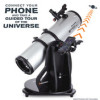Celestron StarSense Explorer 150mm Smartphone App-Enabled Tabletop Dobsonian Tel - Page 11
Determining Magnification, And Selecting Eyepieces, Cooling Your, Telescope's Optics
 |
View all Celestron StarSense Explorer 150mm Smartphone App-Enabled Tabletop Dobsonian Telescope manuals
Add to My Manuals
Save this manual to your list of manuals |
Page 11 highlights
DETERMINING MAGNIFICATION AND SELECTING EYEPIECES To change the magnification of the telescope, you'll need to swap out the eyepiece in the telescope's focuser. To calculate the magnification you can achieve with a given eyepiece, use this formula: Focal length of telescope ÷ Focal length of eyepiece = Magnification The SSE Dobs have a focal length of 1200mm. They come with a 25mm Omni Plössl eyepiece. Using the formula, we can calculate that this combination yields a magnification of 48x (1200mm ÷ 25mm = 48x). This is an excellent magnification for locating and observing wide-field deep space objects. You may want to consider purchasing a higher-magnification eyepiece, like a 10mm Omni Plössl, for higher-power views of the Moon and planets. Do not increase magnification too much though, or the view may degrade due to atmospheric seeing conditions (i.e. air turbulence). The maximum magnification for any telescope is about 60 times per inch, which equates to 480x for the 8" SSE Dob, and 600x for the 10" SSE Dob. In many locations, however, it will be difficult to achieve sharp images much over 100x magnification due to turbulence in the air above you. If you notice that the stars overhead are twinkling heavily, seeing conditions are poor. You should stick to lower magnification. If the stars appear to shine steadily, seeing conditions are good. You can try using higher-magnification eyepieces. The SSE Dobs can accept both 1.25" and 2" format eyepieces. 2" eyepieces generally provide a wider field of view but can cost significantly more. To use a 2" eyepiece, remove the 2"-to-1.25" adapter from the focuser and insert the eyepiece directly into the 2" extension tube. Secure the eyepiece with the thumbscrews on the 2" extension tube. The eyepiece rack located on the front of the base provides a convenient place to put eyepieces when they are not in use. It can accept three 1.25" eyepieces and one 2" eyepiece (Figure 13). COOLING YOUR TELESCOPE'S OPTICS You'll get the best views through your telescope when it has reached thermal equilibrium with the ambient air. If the telescope is warmer than the outside air, the mirror will be acclimating to the temperature and its figure will be changing. The images you see through a telescope that has not cooled will not appear as sharp as they otherwise would. If you are taking your telescope from a heated house to the outdoors, allow around one hour before expecting it to produce sharp images. For this reason, we recommend storing your telescope in a dry but unheated area like a garage or storage shed. For the 10" SSE Dob, there is an optional USB Cooling Fan for Dobsonians available. It mounts onto the rear of the mirror cell and blows air on the mirror to expedite cooling (Figure 14). The fan will help the optics reach thermal equilibrium faster. (The 8" SSE Dob does not have a fan mount so it is not compatible with the Cooling Fan.) Figure 13: The eyepiece rack is a convenient place to store additional eyepieces during your observing session. Figure 14: The optional USB Cooling Fan for Dobsonians is compatible with the 10" SSE Dob.. ENGLISH I 11















